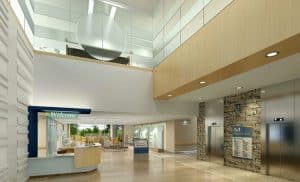
No accounting for some workplace acoustic design
A kind and witty friend, Kevin is a gifted conversationalist who loves socializing and collaboration. He doesn’t, however, care much for overhearing co-workers engage in those activities while he’s trying to focus on his cognitively demanding work as an organizational accountant.
We’d known each other a couple of years when I finally recalled exactly where I’d seen—and heard—Kevin prior to our friendship. Several years ago, my partner and I had been enjoying Friday after-work refreshments in a neighbourhood pub where—as in many pubs—it can be nigh impossible not to overhear nearby conversations. (Although that’s half the fun; am I right?) I was both amused and sympathetic at hearing my now-friend vent to his companion about co-workers he liked well enough, but whose incessant chatter impeded his ability to concentrate on all those data-heavy spreadsheets and forms… I.e. the kind of persnickety paperwork that so often inspires many of us to eschew the DIY route it in favour of hiring a professional to get it out of our bleary-eyed faces.
Pre-pandemic, Kevin’s workplace had been an open-plan office. Today, my friend is grateful that his employer has adopted a hybrid work model. He’ll continue working primarily at home—where his productivity and satisfaction have soared in the last two+ years—coming into the office periodically for meetings and collaborative projects.
Room acoustic planning? It’s a top-down approach.
Post-pandemic realities notwithstanding, the challenges inherent in designing an acoustically optimized open-plan office space haven’t changed much since we addressed them in our 2019 blog post, I Can Hear What You’re Thinking: Open-Plan Office Acoustics Demystified. And the strategies we recommended for addressing those challenges remain applicable.
Now as much as then, reverberation control based on room shape drives effective acoustic design. (Reverberation time is the key parameter for controlling room acoustics and subsequent speech intelligibility levels.)
In addition, we still can’t under-emphasize the importance of installing a sound-absorbing ceiling—ideally, as low as possible—to minimize reverberation. In turn, shorter distances are required between work stations to ensure their occupants’ speech won’t disturb others.
With the proviso that proper ceiling treatment precedes all of these in importance, we still recommend that open-office space planners and designers also consider:
- work station placement
- floor and wall materials (concrete floors, for example, deflect sound and prove especially bothersome in high-ceilinged rooms)
- furniture material and surfaces (again, hard surfaces deflect sound)
- adequately tall sound-absorbent workstation partitions
- silent and collaborative work areas
- work methodology and technical aids
- background noise
- sound masking (these systems subtly increase the level of background noise to reduce auditory workplace distractions and enhance privacy levels)
- The output of such systems must be carefully configured. Too low in volume, and the masking system may fail to provide sufficient masking. Too high, and there is a risk of increasing worker annoyance and lowering productivity. Generally speaking, background noise levels in an open office should not exceed 45dBA. In a cellular office, a 40dBA background noise level is more suitable. (From our 2015 blog post, Office Acoustics: Speech Privacy and Security)
ISO 22955: The new kid in standard town
The International Organization for Standardization (ISO) develops and publishes worldwide technical, industrial and commercial standards. Founded in 1947 and headquartered in Geneva, Switzerland, the ISO represents one of several well-known bodies promoting green building standards generally, and acoustic quality standards specifically.
LEED and WELL both present detailed guidance towards the creation of sustainable and environmentally conscious built environments that promote health and well-being for occupants. Both organizations address acoustic quality as an integral part of achieving those broader goals. Read GREEN ACOUSTICS: Because Noise Pollution Stinks and WELL done acoustics with a side of Green to learn more about how these two standards apply, acoustically speaking.
Providing detailed technical and methodological recommendations, ISO 22955: Acoustic quality of open office spaces is not only more comprehensive than LEED or WELL acoustics-related counterparts—neither of which feature an individual standard for open-office spaces—it also dramatically expands upon ISO 3382-3, the related standard that preceded it.
ISO 22955 also simplifies the notoriously complicated nature of open-office space acoustics, partly by including clear definitions of the most essential room acoustic design principles. Acoustic Bulletin presents a great overview in an article titled Basic Principles of Acoustic Design from ISO 22955:
General
The acoustic treatment of rooms fundamentally involves covering room surfaces with sound-absorbing materials to limit sound reflections. The larger-surfaced and more sound-absorbing a given material is […], the better. Surfaces directly exposed to the sound sources of the room should be prioritized.
ISO 22955: p. 15 – s. 6.4.1
Ceiling treatment
The ceiling is the most important room surface to treat in open offices and should be as sound-absorbing as possible. A wall-to-wall sound-absorbing ceiling is preferable.
ISO 22955: p. 16 – s. 6.4.2
(See! We knew that.)
Wall treatment
Open office wall areas tend to be relatively small compared to those of ceilings. Wall absorbers nevertheless do reduce reverberation time if the open office is sparsely furnished (and therefore lacking diffusion). They also mitigate echoes and sound reflections for workstations located close to walls, particularly in corners. For best results, wall absorbers should be installed at user ear height.
ISO 22955: p. 16 – s. 6.4.3
Floor treatment
Acoustic treatment of open office floor surfaces generally has no significant effect in the absence of highly specialized solutions. Soft flooring does provide slight absorption in the higher frequency ranges, while carpets decrease impact noise from steps and furniture.
In the design and construction of office buildings with access—aka raised—flooring, special care should be taken to facilitate structurally-sound insulation properties.
ISO 22955: p. 16 – s. 6.4.4
Acoustic Screens
Acoustic screens enhance speech privacy by minimizing sound travel distance. Effectiveness hinges on acoustic environmental quality:
The fewer sound-reflective surfaces present, the greater speech privacy acoustic screens provide.
Acoustic screens should be tall enough to sufficiently block direct speech paths between workstations. Furthermore, acoustic screens extending both above and below desk surfaces provide higher degrees of speech privacy. Both sound absorption and attenuation play key roles in determining acoustic screen effectiveness.
ISO 22955: p. 17 – s. 6.5.2
Furniture
Furniture usually proves insufficient to meet the acoustic requirements of open office space. Instead, design priority should be given to treating room surfaces with sound-absorbing materials.
ISO 22955: p. 16 – s. 6.5.1
Room Geometry
Typically characterized by low ceiling height relative to floor area, open offices can further minimize sound propagation when this dimensional ratio is paired with acoustic ceiling treatment. Particularly long and narrow room shapes should be avoided, as they amplify sound propagation through open offices.
ISO 22955: p. 15 – s. 6.4.1
Sound Masking Systems
Sound masking systems—which raise background noise levels with electronically amplified sound sources—are controversial. Evidence exists both for and against their effectiveness.
Laboratory and field studies suggest that noise levels above 45 dB(A) are too loud. Above this level, sound masking systems might also trigger the Lombard effect, defined as the tendency for humans to raise their voices in the presence of noise. In addition, natural sounds appear preferable to white, pink, or other digitally generated noise.
A few words—because excess exhausts—on reader wellbeing & retention
My research for this article yielded such a treasure trove of relevant information that I’ve consequently written a much longer piece than anticipated.
We don’t take your valuable time and attention for granted, kind reader. No doubt you too strive for a healthy work-life balance, and your downtime is precious. We respect that.
In keeping with this respect, I’ll hold off until next month to publish the rest of this article. Well, that, and I don’t want to be this guy:




